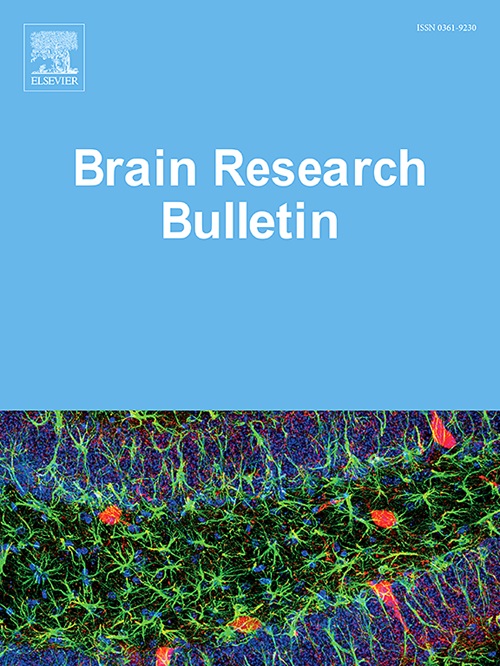Dynamic alterations in spontaneous neural activity in patients with attention-deficit/hyperactivity disorder: A resting-state fMRI study
IF 3.5
3区 医学
Q2 NEUROSCIENCES
引用次数: 0
Abstract
Background
To investigate the change of dynamic amplitude of low-frequency fluctuation (dALFF) and dynamic fractional amplitude of low-frequency fluctuation (dfALFF) in patients with attention-deficit/hyperactivity disorder (ADHD), and to explore whether dALFF/dfALFF can be used to distinguish ADHD from health controls (HCs).
Methods
Forty-eight cases of clinically confirmed ADHD and forty-four cases of HCs were included in the present study. It was compared to the amplitude of low-frequency fluctuations (ALFF) and fractional ALFF (fALFF), as well as the dynamic indicators dALFF and dfALFF. We investigated the relationship between clinical and dynamic indicators, and additionally performed voxel-based functional connectivity (FC) analysis. Finally, we developed an auxiliary diagnosis model.
Results
Brain regions with increased dALFF variability of ADHD were located in right middle frontal gyrus (MFG), left inferior parietal lobe (IPL) and superior parietal gyrus (SPG) compared with HCs. Meanwhile, increased dfALFF variability was also observed in left lingual gyrus (LING), right MFG and left middle occipital gyrus (MOG) in ADHD compared to HCs. Neuropsychological scale scores correlated with some dALFF and dfALFF indicators. Reduced FC was found between the left IPL and right cerebellum crus II in ADHD compared with HCs. With dALFF and dfALFF variability as features, we achieved a good area under the curve and an accurate classification.
Conclusion
This study offers new valuable insights into the cerebral dysfunction associated with ADHD from the standpoint of dynamic local brain activity. The understanding of dALFF/dfALFF variability can contribute to the comprehension of neurophysiological mechanisms and potentially aid in the diagnosis of ADHD.
研究背景研究注意力缺陷/多动障碍(ADHD)患者的低频波动动态振幅(dALFF)和低频波动动态分数振幅(dfALFF)的变化,并探讨dALFF/dfALFF是否可用于区分ADHD和健康对照(HCs):方法:本研究纳入了48例临床确诊的ADHD患者和44例HCs患者。方法:本研究纳入了 48 例临床确诊的 ADHD 患者和 44 例 HC 患者,并将其与低频波动振幅(ALFF)和分数 ALFF(fALFF)以及动态指标 dALFF 和 dfALFF 进行了比较。我们研究了临床指标和动态指标之间的关系,还进行了基于体素的功能连接(FC)分析。最后,我们建立了一个辅助诊断模型:结果:与普通人相比,ADHD的dALFF变异性增加的脑区位于右侧额叶中回(MFG)、左侧顶叶下回(IPL)和顶叶上回(SPG)。同时,与普通人相比,多动症患者左侧舌回(LING)、右侧额叶中回(MFG)和左侧枕叶中回(MOG)的dfALFF变异性也有所增加。神经心理量表评分与某些 dALFF 和 dfALFF 指标相关。与普通人相比,ADHD患者左侧IPL和右侧小脑嵴II之间的FC降低。以dALFF和dfALFF变异性为特征,我们获得了良好的曲线下面积和准确的分类:本研究从动态局部脑活动的角度,对与多动症相关的脑功能障碍提供了新的有价值的见解。对 dALFF/dfALFF 变异性的了解有助于理解神经生理机制,并有可能帮助诊断多动症。
本文章由计算机程序翻译,如有差异,请以英文原文为准。
求助全文
约1分钟内获得全文
求助全文
来源期刊

Brain Research Bulletin
医学-神经科学
CiteScore
6.90
自引率
2.60%
发文量
253
审稿时长
67 days
期刊介绍:
The Brain Research Bulletin (BRB) aims to publish novel work that advances our knowledge of molecular and cellular mechanisms that underlie neural network properties associated with behavior, cognition and other brain functions during neurodevelopment and in the adult. Although clinical research is out of the Journal''s scope, the BRB also aims to publish translation research that provides insight into biological mechanisms and processes associated with neurodegeneration mechanisms, neurological diseases and neuropsychiatric disorders. The Journal is especially interested in research using novel methodologies, such as optogenetics, multielectrode array recordings and life imaging in wild-type and genetically-modified animal models, with the goal to advance our understanding of how neurons, glia and networks function in vivo.
 求助内容:
求助内容: 应助结果提醒方式:
应助结果提醒方式:


